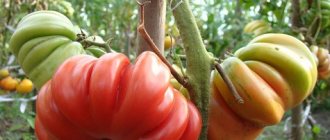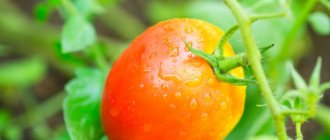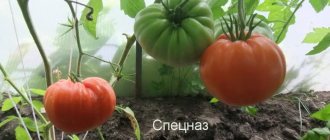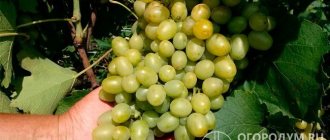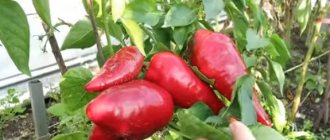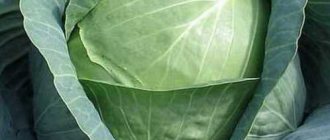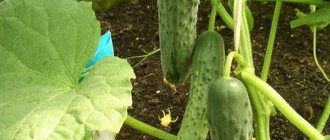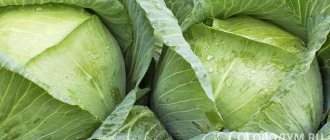The Pink Leader tomato ripens in record time and has an excellent taste for an early variety. In addition, it can even be grown without seedlings, and it bears fruit in areas of risky farming. All these qualities contribute to the fact that the tomato is gaining popularity among gardeners every year.
| Height | Landing location | Ripening time | Fruit color | Fruit size | Origin | Fruit shape |
| short | Greenhouse, Open ground | Ultra early | Pink | Average | Variety | Flat-round |
Description of the tomato variety Pink Leader
This variety has a fast ripening time. The tomato was bred by agro specialists. It can be grown both in greenhouses and in the garden. The pink leader is a determinant. The bush is standard, low-growing (maximum height 50 cm).
It has pubescent branches with large leaves of a rich green hue. When 5 to 7 permanent leaves are formed on the bush, the first ovary will appear. Up to 5 tomatoes ripen on one bunch at the same time. This happens 86-90 days after the first shoots appear. Due to the compact size of the bush, Pink Leader can also be grown on the balcony. It will be a wonderful decorative element.
What not to do
Sometimes there are recommendations online on how to get sweeter tomatoes. Among these recommendations is the addition of table salt to irrigation water. Under no circumstances should you do this, you will ruin the soil and seriously harm the plants! The accumulation of sugars in tomatoes depends on the genetic characteristics of the variety, as well as the provision of heat, light and potassium.
Try growing this variety and see that it is a leader!
Taste qualities of Pink Leader tomatoes
According to reviews from the photo, the yield of the Pink Leader is quite large. Ripe fruits acquire a red tint with delicate pink tints. But unripe tomatoes are colored light green. The weight of one tomato reaches 150-170 g. They have a slightly rounded shape, with ribs appearing on the skin. The pulp is quite dense and juicy. Pink leader tomatoes are sweet, with barely noticeable sourness.
Tomatoes are consumed fresh, as an ingredient for salads, and also for making homemade juices, pastes and ketchups. The variety is not used for pickling. The thin skin quickly cracks, and the workpieces look unaesthetic.
Method of obtaining seeds
As practice has shown, recently many purchased seeds turn out to be of low quality and have poor germination. Gardeners collect seeds from their own harvest and their results are much better.
But quality also depends on doing the right thing.
- To collect seeds, only ripe and large fruits are selected.
- Wash the tomato well, cut it, collect the seeds with a spoon, and place in a glass bowl.
- The seeds should ferment within 1 day at a temperature of 25°.
- Next, place the seeds on cheesecloth and rinse, removing mucus.
- Dissolve a teaspoon of salt in a glass and put seeds into the solution: good ones will sink to the bottom, and bad ones will float to the surface.
- Dry good seeds for a week at a temperature of 25° on a saucer.
The resulting seeds can be stored in a paper bag in a cool, dark place for 3-4 years.
It is better to store the seeds in a glass or plastic bottle with a tight-fitting lid. Storage temperature +14-15 degrees. Under such conditions, seeds can be stored for 5-6 years or more.
Pros and cons of the Pink Leader tomato variety
The advantages of these tomatoes include:
- High yield.
- Strong immunity (Pink Leader bushes are resistant to bacterial and viral diseases).
- Different methods of cultivation (in the ground, greenhouse, seedlings and non-seedlings).
- Good shelf life and preservation of presentation after transportation.
- Resistance to various weather conditions.
- Nutritional value of fruits. They contain a huge amount of minerals and vitamins that protect the heart and blood vessels.
The Pink Leader tomato has practically no negative characteristics. The only thing that may confuse summer residents is the delicate skin and the not too large size of the fruit.
Seedling care
After planting the seeds, the container with the seedlings must be regularly opened and ventilated. Watering is carried out as the soil dries. After the first shoots appear, the film is removed. Watering is carried out once every 2 days. Water must be sprayed with a spray bottle so as not to break the thin sprouts.
After the appearance of the second true leaf, it is necessary to pick. Plants are transplanted into separate cups. After picking, a hardening procedure is carried out. To do this, the greenhouse or window is opened daily. At the beginning, the duration of hardening lasts no more than 3-4 minutes. Gradually the period is extended to 2 hours a day.
Optimal growing conditions
Pink leader can be grown in a variety of conditions. Tomatoes of this variety delight with excellent taste and high yields in greenhouses. They are also actively grown in vertical beds. The pink leader will be a godsend for owners of small plots. Thanks to their compact root system, bushes are often grown in tubs, as well as in multi-tiered beds.
Attention! Pink leader grows well in Siberia and the Urals. Here summers are cool and short, so gardeners prefer to plant early-ripening tomatoes.
Agricultural technology
Numerous experiences of gardeners have shown that this tomato, due to its compactness, can be planted even in small areas. If there are no greenhouses, gardeners are limited to greenhouses or “warm” beds.
Warm beds begin to be made in early May.
Manure, radish tops or grass (one to choose from) are placed at the bottom of the bed. Dilute well with hot water. The top is covered with earth. Cover with film and leave to warm up. After 3-4 weeks everything is ready.
The height of the warm bed should be at least 40-50 cm. The layer of manure - biofuel for heating is 15-20 cm.
This is a good analogue of a greenhouse bed. Tomatoes ripen 2 weeks earlier.
Growing seedlings
Before you sow the seeds, you need to prepare the soil. Any nutritious soil that you can buy in a store will do. Or do it yourself by mixing peat and sand (1:1). Seeds are sown in late March - early April.
Sowing algorithm:
- treat the seeds with a weak solution of manganese;
- make shallow grooves - 1-1.5 cm;
- put seeds in them and spill them;
- lightly cover with soil;
- cover with polyethylene.
After about 5-7 days, the first shoots will appear. After this, the film is removed. The seedlings are placed in a sunny place. When permanent 2-3 leaves appear, the seedlings are pruned.
Transfer
Plants are easy to care for
So, when the seedlings have grown stronger and grown, they already have 5-6 leaves - it’s time to transplant them to a permanent place in open ground or a greenhouse.
During the growing of seedlings, it is recommended to replant the seedlings once. This is how the root system begins to actively develop.
After about 7 days, the seedlings begin to be taken out into fresh air for hardening. Depending on the region, at the beginning or end of May, plants are planted in a permanent place. Planting pattern 50 X 40 cm.
Algorithm:
- prepare the soil - remove weeds and dig up;
- make shallow holes, about half a shovel deep;
- put 10-15 g of nitrogen-phosphorus fertilizer, mix with soil;
- spill the holes with water;
- remove the seedlings from the container and place them in the holes;
- cover with soil, compacting it slightly;
- water again.
Sometimes it happens that when planting, part of the root is accidentally broken off. It's OK! Tomatoes regenerate roots quickly enough and the plant does not die.
Growing
The love of summer residents for the Pink Leader is not accidental. Growing it does not require much trouble, and the harvest is pleasing with its quality and taste.
Growing seedlings
The timing of sowing Pink Leader seeds depends on the climatic characteristics of a particular region. This usually occurs in March or April. First, a suitable container is prepared. It is most convenient to use containers with lids, this will make it easier to provide the plantings with a greenhouse effect.
The seeds of the Pink Leader are pre-sorted, discarding empty grains. After this, the planting material is soaked in a weak solution of potassium permanganate. The containers are filled with soil mixture (sand + peat in equal parts). The surface is leveled and each seed is buried a maximum of 1.5-2 cm into the ground. Next, the soil is watered, and the containers are either covered with lids or sealed with transparent cling film.
As soon as the first sprouts appear, the shelter is removed and the container is moved to a windowsill with soft, diffused light. When the first pair of leaves is strong enough, the Pink Leader seedlings are planted in small pots or cups. When growing tomatoes in seedlings, they are fertilized twice with complex mineral preparations. About 14 days before transplanting the bushes into the garden, the amount of moisture introduced is reduced, and the containers are systematically taken outside to accustom the plants to fresh air and temperature changes.
Landing rules
For Pink Leader tomatoes, light areas protected from gusts of wind are suitable. The earth should be well heated by the sun. As for the soil, the best option for the Pink Leader would be nutritious, fairly loose soil, which will allow the necessary moisture and oxygen to pass to the roots. The site is prepared in the fall: the ground is dug up and fertilized.
Transplantation begins no earlier than May. By this time, the air and soil will have time to warm up well. Holes are made in an area that has been prepared in advance and cleared of weeds. The best planting scheme is 5040 cm. Thus, about 8 Pink Leader bushes will fit on every 1 m2 of land.
The landing technique looks like this:
- Dig holes in advance and water them with warm water.
- Carefully remove the bushes from the pots so as not to damage the delicate roots. Place them in the holes. Tomatoes are buried down to the cotyledon leaves.
- The top of the planting is sprinkled with earth and compacted a little.
Watering and fertilizing
It is necessary to constantly monitor soil moisture. In dry soil, the fruits of the Pink Leader become small and lose their unique taste. With a severe lack of moisture, the bushes may be attacked by insects and die. After each watering, the soil is loosened so that a crust does not appear on its surface, which prevents the circulation of oxygen and moisture to the roots.
The Pink Leader is fed 3 to 4 times per season. It is best to use complex mineral preparations for this. You should not fertilize the bushes too often. Excessive feeding leads to weakened immunity and poor harvest. This applies in particular to nitrogen. If there is too much of it, the bushes will build up green mass, producing virtually no fruit.
Pinching and tying
It is necessary to remove the lower leaves in time. If this is not done, they will grow and air will accumulate near the soil. Such stagnation provokes the development of various diseases in the Pink Leader.
Attention! Determinate standard bushes of the Pink Leader do not require garter. The plant reaches about half a meter in height and is not prone to strong branching.
Formation
The bushes do not require complex care. However, they need to be formed, leaving a pair of strong, well-developed stems. The more green shoots there are, the more difficult it is for the plant to saturate the fruits with useful substances. Therefore, part of the ovary falls off, and the remaining fruits ripen very poorly.
Protection from diseases and pests
Of the diseases, the most important to be wary of are brown spot, rot and late blight.
The most dangerous insects for the Pink Leader are the Colorado potato beetle, sprout fly, whitefly and mole cricket. With proper care, plants remain strong and healthy.
To avoid problems, you need to follow these rules:
- Every 5 years, plant tomatoes in a new place. Plantings should be located as far as possible from potatoes. It is he who is the main source of infections.
- Use only high-quality seeds for planting. You need to purchase them only in specialized stores, checking the expiration date on the packaging.
- When growing tomatoes, you must strictly follow all recommendations and try to create optimal conditions for the growth and development of the bushes.
- The correct regime of fertilizing and watering has a beneficial effect not only on the yield, but also on the resistance of plants to diseases.
Diseases and their prevention
The Pink Leader variety has good immunity against diseases inherent in tomatoes, but this does not exclude the possibility of infection with late blight, gray rot, and brown spot.
High-quality seed material is one of the conditions for a good harvest
To avoid crop losses and save money, it is better to resort to effective preventive measures, which include:
- Maintaining crop rotation . Do not plant tomato seedlings in their previous location earlier than five years later. And also plant tomatoes away from potato plantings, which are the primary carrier of the infection.
- Using only high-quality planting material . Before sowing, complete all necessary measures to prepare the seeds for planting.
- Compliance with the rules for soil preparation and planting according to all standards, which is considered a guarantee of successful plant growth.
- Creating comfortable conditions for the normal development of tomatoes.
- Correct application of fertilizers . Do not use manure and fresh compost for vegetables, only humus and well-rotted compost.
The main thing is to notice the first symptoms of plant infection in time, quickly recognize the disease and properly improve the health of the tomato bed.
general characteristics
An early ripening, low-growing, productive tomato variety for open ground and film shelters.
Suitable for growing without seedlings in areas of unsustainable agriculture. The period from germination to the beginning of ripening is 85-90 days. Bush of determinant type, standard, 40-50 cm high. Does not require pinching. The leaf is large and green. The inflorescence is simple.
The Pink Leader tomato is included in the State Register of the Russian Federation for cultivation in open ground and under film covers in private household plots.
The fruits are flat-round, dense, pink in color at maturity, weighing 120-150 grams, fleshy, good taste for early varieties.
Productivity of the Pink Leader variety: up to 8 kg of fruits per 1 sq. meters of landings.
Advantages of tomato: resistance to late blight and adverse weather conditions, friendly yield.
Tomato Leader is a determinate, low-growing variety. The bushes are thick and strong, moderately spreading and sparsely leafy. Shoots do not grow higher than 50-60 cm.
Ripening dates are early - 95-110 days from germination.
Characteristics of tomatoes:
- average weight 70-100 g;
- seed nests, few seeds;
- the pulp is fleshy, sugary;
- the skin is strong;
- The taste is dominated by sweetness.
Pink Leader tomatoes were bred agro. In 2008, it was included in the State Register and recommended for cultivation in open and protected ground throughout Russia.
The variety is ultra early ripening. From the first shoots to the receipt of fruits, only 2.5 months pass.
Description of the bush
The plant is low (45-50 cm), compact. Practically does not require pinching and shaping.
The bushes are small, so you can plant up to 7-8 pieces per 1 m² and get up to 16 kg of fruit in total.
The tomatoes set and ripen at the same time. And this is another advantage when harvesting. The foliage is dark green, oblong.
Description of fruits
Tomatoes Pink leader against the background of a small bush are quite large, about 150 g. Beautiful soft pink color, smooth, rounded.
The pulp is fleshy and dense, the taste is quite sweet, so children love the fruits, and they are also recommended for people with high acidity.
To increase the shelf life of the crop, it is advisable to wrap each specimen in paper and put it in the refrigerator, periodically changing newspapers to keep it dry.
Productivity
Among its determinate counterparts, this tomato is the most productive. In open ground you can collect up to 10 kg/m², and in protected ground – up to 15-16 kg.
Productivity is fully influenced by soil fertility. It should be light, breathable, rich in organic matter and minerals. The variety needs to be watered systematically, especially during the period of fruit ripening.
Application of fruits
The fruit has a sweet taste
Thanks to its taste, the tomato is loved by many. It has a sweet taste and minimal acidity. It is useful to eat it fresh in salads, in freshly squeezed juices, and goes well with other sliced vegetables.
According to the description, a tasty and rich taste is obtained when preparing tomato paste and ketchup.
But this variety is not entirely suitable for canning. During heat treatment, the thin skin bursts and the contents spill out. The appearance is not aesthetic, and the product deteriorates faster due to the damaged outer shell.
According to the description, the Pink Leader tomato has high immunity. Thanks to this property, it can combat weather changes and has high frost resistance.
The variety is resistant to a number of fungal diseases. And first of all – to late blight. But don't forget about prevention.
You can spray with Bordeaux mixture to prevent fungal diseases.
Or you can use folk remedies, for example, an infusion of garlic inflorescences (25-30 pcs per bucket of water, leave for 1-2 days and spray the tomatoes).
Growing regions
Pink Leader is an early ripening variety, so tomatoes are grown throughout Russia.
It is especially popular in the middle zone, the Urals, and Siberia. Summer in these regions is cold and short, so gardeners choose varieties with quick ripening.
This variety is a record holder among early ripening tomatoes. Fruiting lasts from early July to mid-September.
Tomato Pink leader "Sedek" is considered an ultra-early variety - 85-90 days pass from the appearance of the first shoots to the ripening of the fruits. It is listed in the State Register of the Russian Federation and is recommended for cultivation under film or in open ground.
The plant is standard, low-growing, determinate, that is, it stops growing upward when the fruits begin to develop on the clusters. Its height is 40-50 cm, the stems are powerful and strong. The leaves are dark green and large. Tomato stalks are articulated. The inflorescence belongs to the simple type.
The fruits are average, 120-150 grams each, sometimes reaching 170 grams. At maturity they are deep pink in color. They have a flat-round shape and may have slight ribbing. The pulp is dense, but not hard, fleshy and juicy. It contains a lot of sugar, the taste is sweet, the sourness is weak.
Tomatoes are distinguished by a significant content of lycopene, which can fight atherosclerosis, as well as vitamins C, PP and B.
Universal use - both for canning and pickling, and for preparing salads, various dishes and cuts, sauces, pastes. Tomatoes make very tasty juice.
Exhibition
Exhibition tomatoes are not limited in growth and are intended for growing in a greenhouse. The height of the bushes reaches 2 m, so the branches should be tied to supports. The weight of ripened vegetables reaches 600 g in a favorable climate and the use of fertilizers. The pulp is dense, without hard partitions.
Pierce's Pride
The fruits of the Pierce's Pride variety ripen 120 days after planting in the ground. The plants bear flat-round tomatoes weighing up to 400 g. A distinctive characteristic is the increased juice content, which makes the pulp richer. Vegetables are suitable for fresh consumption or processing.
Sweet kiss
Sweet Kiss tomatoes are small-fruited. The harvest ripens 3 months after sowing for seedlings. Plants adapt to temperature changes and bear fruit even when exposed to cold weather. The bushes grow up to 1.5 m and need shaping.
Green goddess Xanadu
The Green Goddess Xanadu variety, unusual in appearance, bears dark green fruits weighing 100-250 g. The shape of the vegetables is round-flat, the flesh is juicy and sweet. The yield from each bush reaches 4 kg. Multi-purpose fruits are suitable for fresh consumption and long-term storage.
Sweet Baby
The Sweet Baby variety, popular among gardeners, is an early ripening variety and ripens 100 days after sowing. Vegetables have a round shape, thick skin and juicy pulp. The yield reaches 3 kg from one square of land. The weight of one small fruit is about 10 g.
Green giant
One of the ancient varieties is the Green Giant. The variety bred in Germany is tall, mid-season and productive. Powerful bushes reach a height of 1.8 m, so they require fixation on supports. The weight of the fruit is 600-800 g.
Sweet Pia
A rare wild tomato variety, Sweet Pia, bears small fruits with sweet pulp. From each bush it is possible to collect up to 3 kg of harvest.
Ildi
The Ildi tomato variety is distinguished by the ripening of many small fruits, the weight of which does not exceed 15 g. Each bunch grows up to 60 copies. The shape of the vegetables is oval, plum-shaped. The pulp is rich and sweet. Ripe fruits can be used for fresh consumption and canning.
Kishinevskie
Chisinau tomatoes of medium ripening are intended for growing in greenhouse conditions. From the moment of sowing the seeds until harvesting, 105-110 days pass. The raspberry-colored fruits weigh up to 500 g. Universal vegetables are used for making juice, salads and fresh consumption.
Pink honey
Determinate, mid-early variety Rose honey is grown in a greenhouse and in open ground. Plants reach 1.5 m and bear fruits weighing 300-600 g. The pulp of vegetables is juicy, fleshy and sweet. With constant care and favorable weather conditions, the yield is 3.8-4 kg per square meter of land.
Roma
Roma tomatoes grow on powerful bushes of the determinate type. The height of the plants is 65-75 cm. The variety demonstrates the highest yield when formed with a single stem and fixed to vertical supports. This variety is resistant to a number of diseases, including fusarium and verticillium.
Camellia
The high-yielding Camellia variety is used for growing indoors. Indeterminate bushes reach a height of 2-2.5 m. Due to the weighty fruits and large height of the plants, fixation on supports and regular removal of stepsons is required.
